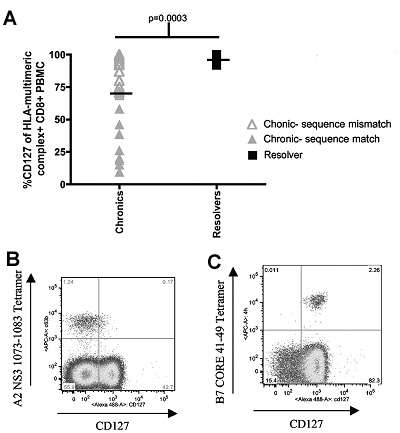Your basket is currently empty!
Hepatitis-C-Virus-infection
Case Study:
Pro5® Pentamers and viral escape in chronic Hepatitis C Virus infection
Kasprowicz, V., et al. (2010). Hepatitis C virus (HCV) sequence variation induces an HCV-specific T-cell phenotype analogous to spontaneous resolution. J Virology. 84(3) :1656-63. [PubMed ID: 19906915]
Hepatitis C virus (HCV) remains today a major global health concern. There is no preventative vaccine, and the majority of infected individuals (some 3% of the world’s population) go on to become carriers, which entails long-term health risks. CD8+ T cells (CTL) from patients target the disease, but in a battle with the virus, they often lose.
Kasprowicz et al used ProImmune’s Hepatitis C Virus (HCV) Pro5® Pentamers to investigate the HCV-specific CTL persisting in individuals with chronic infection. These cells are low frequency, which might be expected, but more surprisingly, they exhibit a phenotype more commonly associated with resolved infections, expressing the memory marker CD127.
The team were able to resolve this apparent discrepancy, demonstrating that the CD127low, virus-specific CTL were not specific for the HCV variants circulating in infected individuals. CD127, part of the IL-7 receptor, is normally only expressed on CD8+ T cells specific for antigens from controlled infection; thus CD127 expression is usually low on CTL specific for persisting viruses and high on CTL specific for acute resolved infections such as influenza.
Virus-specific responses in cohorts of patients with acute, chronic or resolved HCV infections were compared. In chronically infected individuals a range of levels of CD127 expression on virus-specific CTL was visible, while as would be expected, all HCV-specific CTL in the resolved patients were CD127high (Figure 1A).
The team explored this observation further, since HCV has the potential to escape a CTL response through mutation. Sequencing of the virus in chronically infected individuals demonstrated an interesting correlation. While there was a perfect match between T cell epitope and autologous virus in chronically infected patients with low CD127 expression (Figure 1B), those patients expressing higher levels of CD127 did so only on cells that were not specific for circulating virus (Figure 1C): there remains an absence of CD127high CTL specific for autologous virus in these individuals, explaining the persistence of HCV infection.
 |
Figure 1: Chronically infected individuals express a range of CD127 levels on HCV-specific T cells. (A) CD127 expression levels on HCV-specific T-cell populations in individuals with established chronic or resolved infection. While individuals with resolved infection uniformly express high levels of CD127, chronically infected individuals exhibit a wide range of CD127 expression levels. (B) Low CD127 levels are observed on HCVNS31073-1081 (CINGVCWTV) -specific T cells from an individual with chronic HCV infection and an intact autologous sequence. (C) CD127 expression levels on HCVcore41-49 (GPRLGVRAT) -specific T cells from an individual with resolved HCV infection. |
Using genotype-specific T cell lines, and ELISPOT assay, it has previously been shown that expression of CD127 in the presence of viral infection is closely associated with the capacity of the patient’s CTL to recognize virus. This was borne out by the case of one patient participating in the study by Kasparowicz et al: antiviral therapy led to the loss of CD127negative HCV specific CTL and the emergence of a CD127+ population.
By following the progression of HCV infections over a period of months, using Pro5® Pentamer staining to track CTL phenotype, the team were able to conclude that CD127 expression is dependent on the absence of ongoing antigenic stimulation (due to either viral clearance or viral variation). During the early stages of an acute infection, CD127 expression is low or absent, and increases during the course of a response. Re-encounter with antigen led to an expansion of naïve, CD127low cells in these patients.
Taken together, the data suggest that CTL responses in chronically HCV infected individuals exist but fail to target the circulating virus, so enabling the infection to persist. This observation extends our ability to target persisting infections, looking beyond CTL we now know to be ineffective against circulating virus, and allowing us to focus on stimulating useful CD127low CTL to eliminate the disease.
ProImmune Pro5® Pentamers Used:
| F003-2A | A*02:01/CINGVCWTV | HCV NS3(1073-1081) |
| F742-2A | B*07:02/GPRLGVRAT | HCV core(41-49) |
Figure reproduced (with amendments) with permission from the American Society for Microbiology
